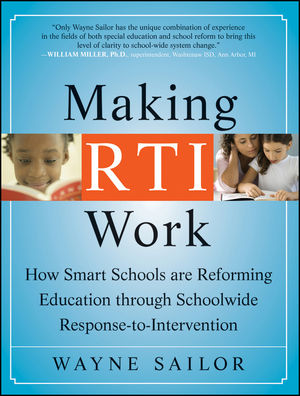Making RTI Work: How Smart Schools are Reforming Education through Schoolwide Response-to-InterventionISBN: 978-0-470-19321-1
Paperback
336 pages
October 2009, Jossey-Bass
 This is a Print-on-Demand title. It will be printed specifically to fill your order. Please allow an additional 10-15 days delivery time. The book is not returnable.
|
||||||
Foreword (Leonard Burrello).
Acknowledgments.
The Author.
Preface.
Part One: The Origin and Design of Schoolwide RTI.
1 Defining RTI.
Features of RTI.
Standard Protocol RTI.
Schoolwide RTI.
Evolving Definitions of RTI.
Standard Protocol Definitions.
Combined Standard Protocol and Problem-Solving Definitions.
Schoolwide Definitions.
Comprehensive Schoolwide RTI.
To Sum Up.
2 Schoolwide RTI: Why Does It Matter?
The Frame of Disability.
RTI as a Potential Frame for Education Policy.
A Focus on literacy.
A Shifting Perspective.
RTI as a Basis for Education Policy.
Prevention.
Problem Identification.
Interventions.
Accountability.
A Focus on Sociobehavioral Factors.
RTI and Academic Progress.
Transdisciplinary Problem-Solving Teams.
Decision Rules for Selecting Interventions.
To Sum Up.
3 The Social-Behavioral Side of RTI.
School Discipline.
The Tactic of Exclusion.
The Tactic of Inclusion.
Schoolwide Positive Behavior Support.
Understanding SWPBS.
Evidence-Based Practice.
Practical, Multicomponent Interventions.
Lifestyle Outcomes.
Sustainable Systems Change.
To Sum Up.
Part Two: How Schoolwide RTI Works.
4 Universal Screening for Prevention.
Determining Success Criteria.
Behavioral Screening Under RTI.
School-Based Screeners for Behavioral Risk.
Internalizers or Externalizers.
Standardized Screeners for Behavioral Risk.
Systematic Screening for Behavioral Disorders.
Academic Screening Under RTI.
Universal Academic Screening.
Screening Accuracy and Efficiency.
Normative and Criterion–Referenced Screeners.
Curriculum Based Measures.
Universal CBM.
DIBELS, AIMSweb, and iSTEEP.
Advantages of Universal CBM Screening for Teachers.
Combining Results of Behavioral and Academic Screening Under RTI.
RTI Team Processes and Coaches.
RTI and School Teams.
Coaches.
To Sum Up.
5 Progress Monitoring to Measure Success.
Educational Accountability.
Types of Assessment for Progress Monitoring.
Proximal Versus Distal Assessments.
Formative Versus Summative Assessments.
Categorical Versus Aggregate Assessments.
Behavioral Progress Monitoring.
Direct Measures of Problem Behavior.
Level 3 Progress Monitoring for Behavior.
Wraparound and SIMEO.
Academic Progress Monitoring.
Level 1 Progress Monitoring.
Level 2 Progress Monitoring.
Level 3 Progress Monitoring.
RTI and the Organization of Service and Supports.
To Sum Up.
6 Sustaining RTI Through School Reform.
Challenges Confronting Schoolwide RTI.
Silos Revisited.
Human Capital.
Professional Development.
School Reform as a Context for RTI.
Comprehensive School Reform Demonstration Project.
A Universal Design for Learning.
The Schoolwide Applications Model.
Fidelity of Implementation.
SAM Fidelity Assessment Tool.
Scaling Up School Reform.
Moving Schoolwide RTI to Scale in a District.
Action Planning in Schoolwide RTI.
Program Evaluation.
Structural Elements of SAM.
A Model for Technical Assistance.
District and Site Leadership Teams.
To Sum Up.
Part Three: Seeing RTI in Action
7 How RTI Looks at the Schoolwide Level.
Critical Features of Schoolwide RTI.
RTI and the Achievement Gap.
Student Motivation.
School-Based Video.
Leadership and Structure of the RTI School.
Distributed Leadership.
Leadership Teams.
Madison Elementary School.
Screening at Madison.
Building-Level Versus State-Level Assessments.
Reading Interventions.
Fidelity of Intervention.
Professional Development.
Scheduling.
Reflections on Madison Elementary School’s RTI.
Coaching and Collaborative Teaching.
Coaching.
Collaborative Teaching.
To Sum Up.
8 How RTI Looks at the Districtwide Level.
Scaling Up in the District.
Creating Some Fanfare.
Policy Analysis.
Engaging the Board of Education.
Managing Publicity.
Getting Started in the District: Selecting Schools.
Clusters and Cohorts.
Leadership Qualities.
Manageable Cohorts.
Professional Development.
Capacity Building.
RTI in the Louisiana Recovery School District, New Orleans.
RTI Team.
Progress Monitoring.
Level 1 Interventions.
Level 2 Interventions.
Level 3 Interventions.
The Role of Special Education.
Reflections on the Recovery School District.
To Sum Up.
9 How RTI Looks at the Statewide Level.
Federal Policy and RTI.
Kansas Multi-Tiered System of Support.
Colorado Multi-Tiered Model of Intervention and Instruction.
New Hampshire Responds Model.
State Request for Application.
Components of New Hampshire Responds.
To Sum Up.
Conclusion: The Shape of Schools to Come.
No Child Left Behind and Adequate Yearly Progress.
A Privatization Agenda?
Response to Intervention.
Three Facets of Teaching.
Science.
Relationships.
Inspiration.
A Framework, Not a Magic Bullet.
RTI for the Endangered School.
Capacity Building and Sustainability.
Leadership.
Stability.
Capacity.
Potential Traps in Implementing RTI.
Multilevel Sets of Interventions
Screening.
Progress Monitoring.
Interventions.
Fidelity.
The Undeniable Thrill of Success.
To Sum Up.
Sources, References, and Additional Resources.
Index.



